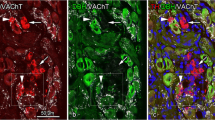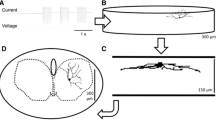Abstract
We have used carbocyanine dye tracing techniques to examine the distribution of afferents from the facial, trigeminal and vagal nerves to the nucleus of the solitary tract (NST) in the developing rat (E13 to P13). Crystals of DiI (1, 1’-dioctadecyl-3,3,3’,3’-tetramethylindocarbocyanine perchlorate) were placed (unilaterally) into the facial or trigeminal ganglia, or into the cervical vagus nerve, and the sections examined with a laser scanning confocal microscope. Inputs from some peripheral structures (tongue, aortic arch, right atrium and lung) to the NST were also analyzed to provide information on the distribution of organ-specific afferents. No afferents were labeled following DiI placement in the above sites at E13. At E14, a few axons from the geniculate ganglion of the facial nerve were present in the NST anlage, but these were restricted to the area adjacent to the solitary tract. These axons began to invade the medial NST at E15. By E17, facial afferent axons had become widespread throughout rostral NST and from E19 the distribution of DiI labeling displayed a morphologically mature pattern. DiI-labeled afferent axons from the trigeminal nerve first emerged into the NST anlage at E14, initially coursing medially to penetrate the ventricular zone. Between E15 and E17, axonal density increased markedly but after E17 became progressively confined to the lateral NST. Axons from the vagus nerve first appeared in the caudal NST as early as E14 and coursed directly into the proliferative zone of the alar plate at all rostrocaudal levels by E15. From E19 through postnatal life, the distribution of vagal afferent axons was essentially stable with particularly dense label in the caudal NST. Cranial nerve afferents to the NST appear to be distributed to appropriate sites from the beginning of ingrowth, with the exception of trigeminal afferents, where some small initial exuberance was found. The terminal fields derived from selected peripheral organs such as lung, right atrium, aortic arch and tongue were also predominantly distributed to appropriate subnuclei from the beginning of ingrowth into the NST, although organ-specific afferent fields appeared to develop dense arbors somewhat later than did individual cranial nerves. Electron microscopy was used to examine regional synapse development in the rat NST. There was some delay between the ingrowth of afferents to the NST (E15) and the first appearance of synaptic thickenings. The earliest synapses were simple (usually) symmetrical membrane thickenings (from E17) and vesicles did not appear until E19. High synaptic density within the C subnucleus appeared during early postnatal life. Synaptic glomeruli, which are a characteristic feature of afferent input to the adult NST, had not developed by birth, indicating that the pre- and perinatal function of the NST must be mediated through simpler, single, axodendritic inputs to NST neurons.
Similar content being viewed by others
Author information
Authors and Affiliations
Additional information
Accepted: 22 March 2001
Rights and permissions
About this article
Cite this article
Zhang, LL., Ashwell, K. The development of cranial nerve and visceral afferents to the nucleus of the solitary tract in the rat. Anat Embryol 204, 135–151 (2001). https://doi.org/10.1007/s004290100185
Issue Date:
DOI: https://doi.org/10.1007/s004290100185




